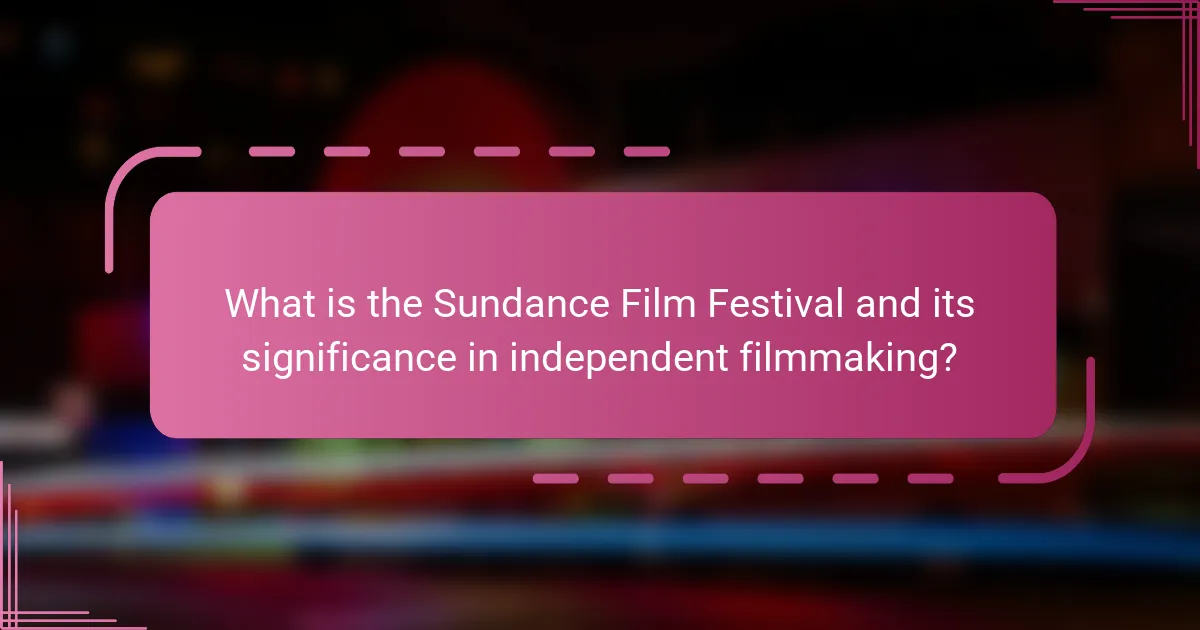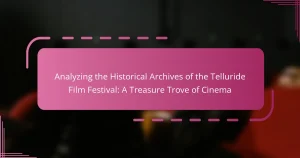The Sundance Film Festival is a prominent annual event held in Park City, Utah, dedicated to showcasing independent films and supporting filmmakers. Established in 1978, the festival has played a crucial role in the independent film industry by providing funding opportunities and fostering connections between filmmakers and industry professionals. Key historical milestones include its founding by Robert Redford, the introduction of the Audience Award, and its adaptation to virtual formats. The festival has significantly impacted the visibility of diverse voices in cinema, encouraging innovation and collaboration, which will continue to shape the future of independent filmmaking.

What is the Sundance Film Festival and its significance in independent filmmaking?
The Sundance Film Festival is a premier event showcasing independent films. Founded in 1978, it aims to support and promote independent filmmakers. The festival takes place annually in Park City, Utah. It serves as a platform for new voices in cinema. Many acclaimed filmmakers gained recognition through Sundance. Films like “The Blair Witch Project” and “Little Miss Sunshine” debuted there. Sundance significantly impacts the independent film industry by providing funding opportunities. It also fosters connections between filmmakers and industry professionals. The festival has become a cultural touchstone for indie cinema.
How did the Sundance Film Festival originate?
The Sundance Film Festival originated in 1978 as the Utah/US Film Festival. It was created to promote independent filmmakers and showcase their work. The festival was founded by a group of filmmakers, including Sterling Van Wagenen and John Earle. In 1981, Robert Redford became involved and helped to rebrand it as the Sundance Film Festival. The festival quickly gained prominence, attracting filmmakers and audiences from around the world. Today, it is one of the largest and most prestigious independent film festivals globally. The festival has significantly impacted the independent filmmaking landscape, launching many successful careers.
What were the initial goals of the Sundance Film Festival?
The initial goals of the Sundance Film Festival were to promote independent filmmaking. The festival aimed to provide a platform for new filmmakers. It sought to showcase innovative and diverse storytelling. Sundance wanted to connect filmmakers with audiences and industry professionals. The festival also aimed to encourage the production of independent films. By highlighting unique voices, it sought to challenge mainstream cinema. These goals were established to foster creativity and artistic expression in film. Sundance has played a crucial role in transforming the landscape of independent filmmaking since its inception.
Who were the key figures involved in the establishment of the festival?
The key figures involved in the establishment of the Sundance Film Festival include Robert Redford, who founded the festival in 1978. Redford aimed to promote independent filmmakers and their work. The festival was initially called the Utah Sundance Film Festival. It was established in response to the growing need for a platform for independent cinema. Other significant contributors included Sterling Van Wagenen, who served as the festival’s first director. Their collaboration helped shape the festival’s mission and vision. The festival has since grown into a prominent event for showcasing independent films.
Why is the Sundance Film Festival considered a pivotal event for independent filmmakers?
The Sundance Film Festival is considered a pivotal event for independent filmmakers because it provides a significant platform for showcasing their work. Established in 1978, the festival has become one of the largest and most prestigious in the world. It attracts industry professionals, critics, and audiences, offering filmmakers exposure and networking opportunities. Many successful independent films, such as “The Blair Witch Project” and “Little Miss Sunshine,” gained early attention at Sundance. The festival also offers awards and funding opportunities, which can propel filmmakers’ careers. Sundance has a history of launching the careers of notable directors, including Quentin Tarantino and Darren Aronofsky. Overall, its influence on independent cinema is profound, shaping the industry and promoting diverse storytelling.
How has the festival evolved over the years?
The Sundance Film Festival has evolved significantly since its inception in 1978. Initially, it focused on showcasing independent films and supporting emerging filmmakers. Over the years, the festival expanded its programming to include a wider range of genres and formats, such as documentaries and short films. In 1981, it adopted the name Sundance, reflecting its growth and connection to the Sundance Institute. By the 1990s, the festival gained international recognition, attracting major studios and celebrities. This shift increased funding and distribution opportunities for independent films. The festival now features numerous awards and categories, enhancing its competitive nature. Additionally, it has embraced digital technology, allowing online screenings and expanded audience reach. The evolution of the Sundance Film Festival has significantly impacted the landscape of independent filmmaking.
What impact did the festival have on the visibility of independent films?
The festival significantly increased the visibility of independent films. It provided a platform for filmmakers to showcase their work to a broader audience. Many films that premiered at the festival gained critical acclaim and distribution deals. For example, movies like “Little Miss Sunshine” and “The Blair Witch Project” became mainstream successes after their festival debuts. The festival also attracted media attention, which further amplified the reach of independent films. By creating a space for networking, it connected filmmakers with industry professionals. Overall, the festival played a crucial role in elevating independent cinema within the film industry.
What role does the Sundance Film Festival play in promoting diverse voices in cinema?
The Sundance Film Festival plays a crucial role in promoting diverse voices in cinema. It provides a platform for underrepresented filmmakers to showcase their work. The festival features films from various cultural backgrounds and perspectives. In 2021, 40% of the films selected were directed by women. Additionally, Sundance has initiatives aimed at supporting filmmakers of color. The festival also offers funding and resources to diverse projects. This commitment has led to increased visibility for marginalized stories in mainstream media. Sundance’s influence helps shape industry conversations around diversity and inclusion.
How has the festival supported underrepresented filmmakers?
The festival has supported underrepresented filmmakers through targeted funding and mentorship programs. It established the Sundance Institute’s Women’s Initiative to elevate female voices in film. The festival also offers grants specifically for filmmakers from diverse backgrounds. In 2021, it featured over 40% of films by directors of color. This commitment fosters inclusivity in storytelling. The festival’s initiatives aim to create equitable opportunities in the film industry. Additionally, it provides networking opportunities to connect underrepresented filmmakers with industry leaders. These efforts have significantly increased the visibility of marginalized voices in cinema.
What initiatives has Sundance implemented to foster diversity?
Sundance has implemented several initiatives to foster diversity in filmmaking. The Sundance Institute offers the Women at Sundance program, which supports female filmmakers through grants and mentorship. Additionally, the Institute runs the Indigenous Program to elevate Native American storytelling and filmmakers. Sundance also hosts the Latinx Fellowship to encourage diverse voices in film. These initiatives aim to provide resources and platforms for underrepresented communities. In 2021, Sundance reported that 46% of films featured were directed by women or people of color. This commitment reflects Sundance’s ongoing efforts to promote inclusivity in the film industry.

What are the historical milestones of the Sundance Film Festival?
The Sundance Film Festival has several historical milestones. It began in 1978 as the Utah/US Film Festival. In 1981, Robert Redford officially founded the Sundance Institute. By 1985, the festival was renamed the Sundance Film Festival. The festival gained prominence in the 1990s with films like “[censured], Lies, and Videotape.” In 1995, the festival introduced the Audience Award for dramatic and documentary films. In 2002, Sundance launched an online film festival. The festival expanded internationally in 2009 with Sundance London. In 2020, it adapted to a virtual format due to the COVID-19 pandemic. Each milestone reflects the festival’s evolving role in promoting independent filmmaking.
What notable films premiered at Sundance that changed the landscape of independent filmmaking?
“[censured], Lies, and Videotape” premiered at Sundance in 1989 and revolutionized independent filmmaking. The film was directed by Steven Soderbergh and won the Audience Award. Its success demonstrated the viability of low-budget films in mainstream cinema. “The Blair Witch Project” debuted at Sundance in 1999, introducing a new era of found-footage horror. The film grossed nearly $250 million worldwide on a budget of $60,000. “Little Miss Sunshine” premiered in 2006 and received critical acclaim, winning two Academy Awards. It showcased the potential for indie films to achieve commercial success. “Whiplash,” which premiered at Sundance in 2014, highlighted the power of storytelling in indie cinema. It garnered three Academy Awards and emphasized the importance of character-driven narratives. These films collectively transformed perceptions of independent filmmaking and opened doors for future filmmakers.
How did these films influence the industry after their debut?
These films significantly influenced the industry by redefining independent filmmaking standards. They showcased the potential for low-budget productions to achieve critical and commercial success. This shift encouraged studios to invest in more diverse and unconventional narratives. The success of films like “Clerks” and “The Blair Witch Project” demonstrated the viability of grassroots marketing strategies. These films inspired a new generation of filmmakers to pursue unique storytelling approaches. They also led to the establishment of more independent distribution channels. As a result, the industry saw an increase in film festivals dedicated to independent cinema. This evolution fostered a more inclusive and varied cinematic landscape.
What awards have been associated with Sundance that highlight independent talent?
The Sundance Film Festival highlights independent talent through several prestigious awards. The Grand Jury Prize is awarded to the best dramatic and documentary films. The Audience Award recognizes films that resonate most with festival-goers. The Directing Award celebrates outstanding achievements in directing. The Best of NEXT Award honors innovative storytelling in new formats. Each of these awards signifies recognition of artistic merit in independent filmmaking. Sundance has been instrumental in launching the careers of many filmmakers through these awards. Notable winners include films like “The Blair Witch Project” and “Little Miss Sunshine.” These awards contribute to the festival’s legacy in promoting independent cinema.
How has the festival’s programming evolved to reflect changes in the film industry?
The festival’s programming has evolved by incorporating diverse genres and storytelling techniques. This shift reflects the growing demand for inclusivity in film narratives. In recent years, the festival has featured more international films. It has also highlighted underrepresented voices in filmmaking. The rise of streaming platforms has influenced the selection of films. These platforms have changed how audiences consume content. The festival now includes virtual screenings and interactive experiences. This adaptation aligns with industry trends toward digital engagement.
What genres have gained prominence at Sundance over the years?
Documentary and drama genres have gained prominence at Sundance over the years. The festival has showcased a significant number of impactful documentaries since the 1990s. Notable examples include “The Cove” and “Won’t You Be My Neighbor?” which received critical acclaim. Drama films have also seen increased attention, particularly those addressing social issues. Films like “Precious” and “Fruitvale Station” exemplify this trend. Additionally, the festival has become a platform for diverse voices in storytelling. This shift reflects broader cultural movements and audience interests in authentic narratives.
How has the audience demographic shifted at the festival?
The audience demographic at the Sundance Film Festival has shifted significantly over the years. Initially, the festival attracted a predominantly local audience from Utah. In recent years, it has drawn a more diverse group from various regions, including international attendees. The age range has also expanded, with younger audiences becoming more prominent. According to a 2022 survey, 45% of attendees were under 30, up from 30% a decade ago. Additionally, there has been an increase in minority representation among festival-goers. This shift reflects broader changes in the film industry and audience preferences.

What are the future implications of the Sundance Film Festival on independent filmmaking?
The future implications of the Sundance Film Festival on independent filmmaking include increased visibility and opportunities for diverse voices. Sundance has historically championed underrepresented filmmakers, paving the way for future inclusivity. The festival’s focus on innovation encourages new storytelling techniques and formats. As streaming platforms expand, Sundance provides a critical launchpad for films to reach wider audiences. Additionally, the festival’s networking opportunities foster collaborations that can lead to funding and distribution deals. The ongoing support from industry leaders at Sundance will likely continue to shape the landscape of independent cinema. Overall, Sundance remains a vital force in promoting growth and evolution in independent filmmaking.
How might emerging technologies impact the Sundance Film Festival?
Emerging technologies will significantly impact the Sundance Film Festival by enhancing the filmmaking process and audience engagement. Innovations such as virtual reality (VR) and augmented reality (AR) are creating immersive storytelling experiences. These technologies allow filmmakers to explore new narrative structures and audience interactions. Additionally, advancements in streaming platforms are expanding the festival’s reach beyond physical attendees. This enables global audiences to participate in the festival remotely. Data analytics tools are also being utilized to understand audience preferences better. This can inform future programming and marketing strategies. Furthermore, blockchain technology is improving transparency in film financing and distribution. These changes reflect a broader trend of integrating technology into independent filmmaking.
What trends in filmmaking are likely to be showcased at future festivals?
Diversity and inclusion in storytelling will be prominent trends in future film festivals. This includes showcasing films by underrepresented voices. Additionally, the use of technology in filmmaking, such as virtual reality and interactive narratives, will gain traction. Sustainability in production practices is also expected to be highlighted. Furthermore, the rise of streaming platforms has transformed distribution methods, influencing festival selections. These trends reflect shifting audience preferences and industry standards. Historical data shows that Sundance has previously led in promoting such innovations. This pattern indicates that future festivals will continue to evolve in response to these trends.
How can independent filmmakers adapt to changes in distribution models?
Independent filmmakers can adapt to changes in distribution models by leveraging digital platforms. These platforms, such as streaming services and social media, offer new avenues for reaching audiences. Independent filmmakers should focus on creating engaging online content. This includes trailers, behind-the-scenes footage, and interactive promotions.
Utilizing data analytics can help filmmakers understand audience preferences. This information can guide marketing strategies and distribution choices. Collaborating with online influencers can also expand reach and visibility. Additionally, filmmakers should explore crowdfunding as a means to finance projects and gauge audience interest.
The rise of Video on Demand (VOD) services has shifted the traditional distribution landscape. According to a report by PwC, global revenue from online video streaming is projected to reach $70 billion by 2021. This statistic underscores the importance of adapting to digital distribution models. By embracing these changes, independent filmmakers can find success in a competitive market.
What best practices can filmmakers learn from the Sundance Film Festival experience?
Filmmakers can learn several best practices from the Sundance Film Festival experience. First, networking is crucial for independent filmmakers. Sundance provides opportunities to connect with industry professionals and fellow filmmakers. Second, understanding audience engagement is essential. Filmmakers should focus on creating relatable and compelling stories. Third, marketing strategies are important. Sundance showcases how effective promotion can amplify a film’s reach. Fourth, feedback is valuable. Filmmakers can gain insights from festival screenings to refine their work. Lastly, persistence is key in the industry. Many successful filmmakers faced numerous rejections before finding success at Sundance. These practices highlight the importance of community, storytelling, promotion, and resilience in independent filmmaking.
What strategies can independent filmmakers employ to gain recognition at festivals?
Independent filmmakers can employ several strategies to gain recognition at festivals. First, they should create a compelling narrative that resonates with audiences. Engaging storytelling is crucial for standing out. Additionally, filmmakers should focus on high production quality. This includes sound, cinematography, and editing. Submitting to a diverse range of festivals increases visibility. Targeting both niche and prominent festivals can broaden exposure.
Networking is another vital strategy. Building relationships with industry professionals can open doors. Attending festival events and panels allows filmmakers to connect with peers and influencers. Effective marketing of the film can also enhance recognition. Utilizing social media and press releases can generate buzz before the festival. Lastly, filmmakers should consider audience engagement. Hosting Q&A sessions or workshops can create a lasting impression. These strategies collectively contribute to gaining recognition in the competitive festival landscape.
How can networking at Sundance benefit aspiring filmmakers?
Networking at Sundance can significantly benefit aspiring filmmakers by providing access to industry professionals. This festival attracts influential directors, producers, and distributors. Aspiring filmmakers can showcase their work and gain visibility. Networking opportunities often lead to collaborations on future projects. The festival also hosts panels and workshops that offer valuable insights. Filmmakers can learn about the latest trends and techniques. Building relationships at Sundance can enhance career prospects in the competitive film industry. Many successful filmmakers attribute their breakthroughs to connections made at this festival.
The Sundance Film Festival is a significant entity in independent filmmaking, established in 1978 to promote and support emerging filmmakers. This article explores the festival’s historical impact, including its origins, key figures, and milestones that have shaped the landscape of independent cinema. It highlights the festival’s role in increasing visibility for diverse voices, fostering connections within the industry, and showcasing notable films that have transformed perceptions of indie filmmaking. Additionally, the article discusses the evolution of the festival’s programming and its implications for the future of independent cinema.


